Issue 12: Becoming
Eating Spring—What Foraging Teaches Me About Care, Kinship, and Co-becoming
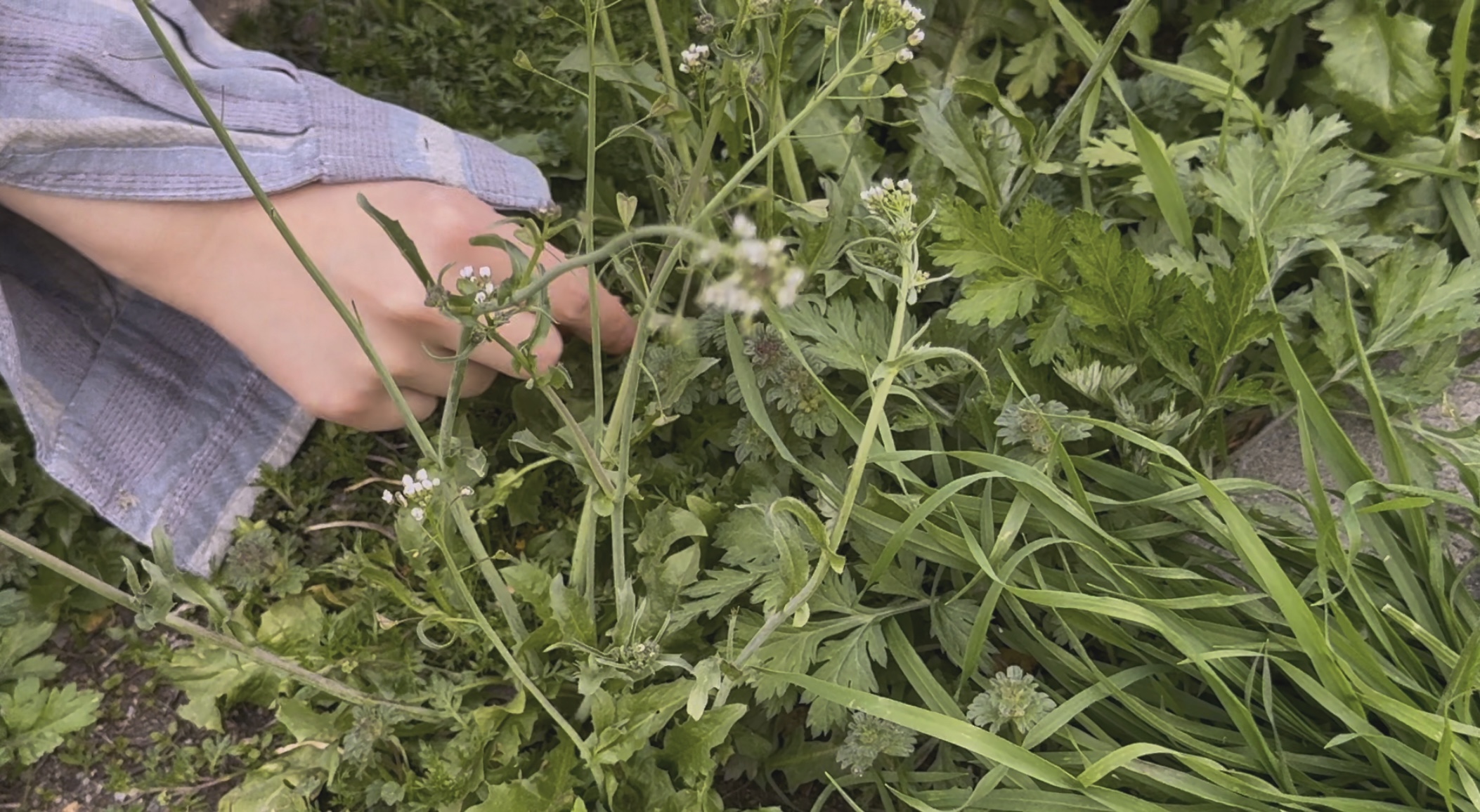
1.
In 2023, when the leaves started to turn gold in New York City, I noticed a pair of Chinese grandmothers walking with bamboo baskets, gathering wild plants from the sidewalks during my regular morning stroll in Sunset Park.
“What are you collecting?” I asked out of curiosity.
“Che Qian Cao (车前草),” they replied in Chinese, barely glancing up as they continued plucking the plants from the ground.
The name struck a chord, stirring up a faint memory from my childhood. I recalled my grandmother in China using Che Qian Cao as a traditional remedy.
“What do you use it for?” I kept asking.
“It’s good for digestion,” one of them said. “You can add it to soup or brew it as tea.”
“Where can I find it?”
At this, they finally looked up at me, “It’s everywhere,” they said, pointing to the unassuming weeds near my feet. “Here, here, and here. Can’t you see?”
2.
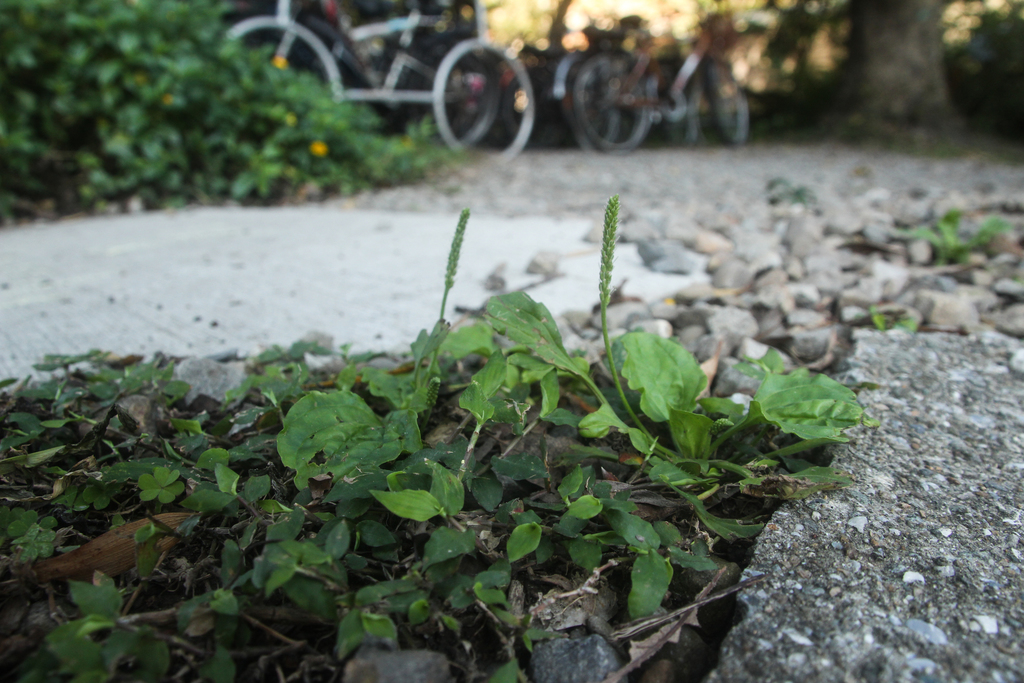
Che Qian Cao (车前草), the name in Chinese literally means “grass grown in front of carriage”. Legend goes that in Han Dynasty, an stableman in army noticed the horses who were gazing on the cow-ear-shaped plants were magically cured from bleeding; Calling it a blessing from heaven, the general then used the plants to cure his soldiers from urinary bleeding and named it “the grass in front of carriage”.
Curiously enough, native Americans once referred to this plant as the “white man’s footprint”, as they noticed this unrecognizable plant – native to Eurasia – started to pop up along European settler’s paths. Che Qian Cao, the white man’s footprint, Plantago major, or more commonly known nowadays as broadleaf plantain, thrive on disturbed lands. As settlers transformed the “newly-discovered” land, these inconspicuous leaves quietly found their way in sidewalk cracks and pavement edges, lawns and wastelands.
Today, plantain is labeled as an invasive plant in North America. “Even among weeds, it’s incredibly persistent,” wrote on Brooklyn Botanic Garden’s Weed’ of the month Blog, “Mow it, step on it, weed-whack it, and this tough perennial will return”. A quick Google Search of the word broadleaf plantain would result in hundreds of articles on “ How to kill plantain”, “What to do with wild plantain infestation in my newly seeded lawn?” — even though these little “invaders” were brought to the shore by colonizers’ footsteps in the first place.
Meanwhile, here on the streets of New York City, elderly women from distant lands—arriving both willingly and unwillingly— pick these weeds up from the edges of the park, carefully collecting them in bamboo baskets, and bring them home to cook a bowl of soup for their family.
In Ursula K. Le Guin’s The Carrier Bag Theory of Fiction, she proposed that the first cultural device in human history—the first technology—was not a spear, arrow, or sword, but a container. “A leaf a gourd a shell a net a bag a sling a sack a bottle a pot a box a container. A holder. A recipient.” she writes, “before the tool that forces energy outward, we made the tool that brings energy home.”
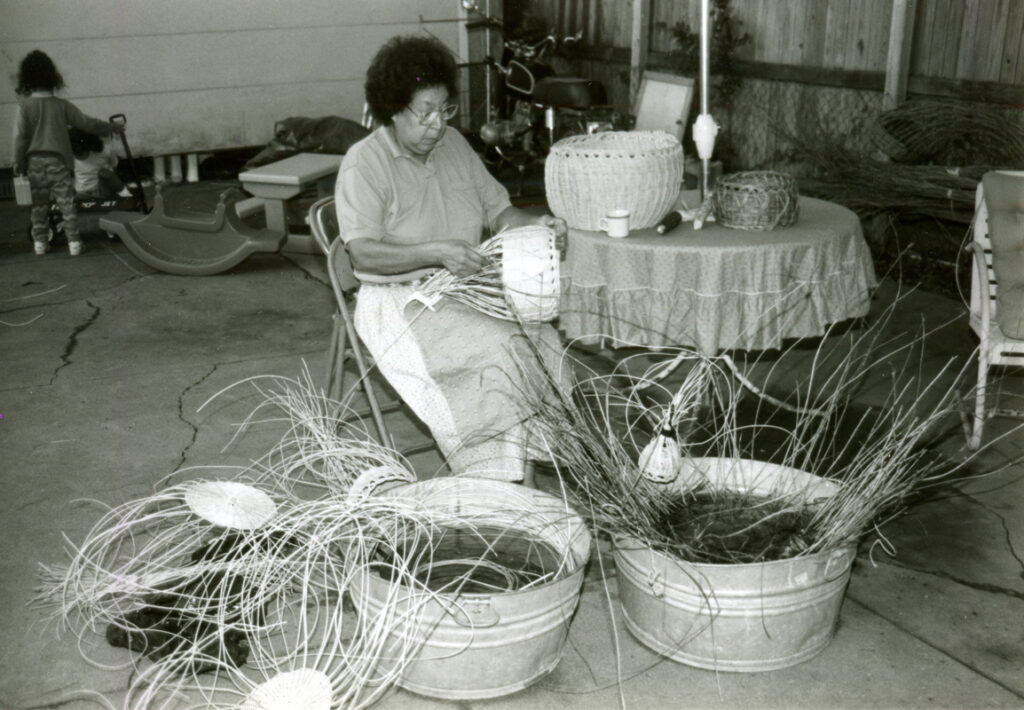
In my class where I teach design and technology, I often ask students to read Ursula K. Le Guin’s as a prompt to rethink technology means before creating anything. How do we unlearn the mindset of techno-fixes or techno-apocalypses that is so embedded in our progress-driven capitalist narratives? How do we reimagine technology and science as primarily cultural carrier bags rather than apparatus of domination? Can we create projects or imagine a future that is grounded in care, cooperating, and co-becoming with other lives(human and non-human)? These are questions I ask both my students and myself all the time.
So when I saw those grandmothers roaming around the city with their baskets, I was immediately captivated. The women who carry the ancient technology on their back to survive in the seemingly most impossible metropolitan. At the same time, I felt an unexpected sense of nostalgia from these feral plants from home, who root themselves in the margin of the foreign land just as I do. I wondered if these strange grandmothers, who spoke my mother tongue, could pass down the cultural and botanical knowledge I had failed to inherit from my own ancestors.
3.
The rest of the autumn, I took longer and longer walks in city parks and looked for trails of those Chinese women. But whenever I asked to interview them or approached them with too many questions, they would quickly walk away with caution and suspicion.
“Did you know that people have gotten arrested for foraging in NYC? ” Muggi said to me when I asked if I could speak with her grandmother, who, according to her, used to forage around the city when Muggi was growing up. Muggi and I had met while sledding in Sunset Park and found we shared a curiosity about the wild plants.
“It’s a strange time,” she said. “There are more and more cops walking around these days, and we don’t want to get into trouble.”
She went on to explain to me that her grandma, a first generation Chinese American, used to forage out of necessity. “ She foraged because we were poor growing up and we needed food, not just for fun like us. It is not something she is proud of and I’d feel weird asking her to be interviewed for that.”
I came to understand the caution I had come across – it is not personal, but shaped by policy. The New York City Department of Parks & Recreation prohibits the removal of any plants, mushrooms, or wildlife from public parks, making foraging technically illegal. Even though documented cases of fining are rare (Food Law Gone Wild: The Law of Foraging), these women—many of them first-generation immigrants—were already navigating a society where they had little access to legal or other institutional resources. The risk of being fined or confronted by an authority figure, no matter how small, was something they do not want to afford.
The irony is that almost all the plants they were gathering—plantain, mugwort, and burdock – are designated by the same institution as invasive species, harmful to the local ecosystem. And yet, the act of removing them is still prohibited. It is a contradiction deeply embedded in the logic of capitalist land management: land is managed for extraction, profit, and control. Anything that does not generate such value becomes waste or weeds.
Historically, the enclosure of common land laid the foundation for capitalist social relations, allowing the ruling class to accumulate wealth while pushing those who once relied on communal subsistence—primarily women and marginalized communities—into dependence on waged labor or patriarchal household structures (Federici, Caliban and the Witch, 2004). In “Food Law Gone Wild, The Law of Foraging“, Linnekin traced the origin of American anti-foraging law to “contempt for the rights of those deemed by those in power to be ‘other’”. Examples include laws that drove the Powhatan people from their ancestral hunting and foraging grounds and post-Civil War restrictions designed to prevent newly freed African Americans from sustaining themselves through foraging.Modern foraging regulations are built upon this legacy. The cautious glances and hurried footsteps of those immigrant women in the NYC parks are echoes of this history—a history in which survival and sustenance have long been dictated by laws that were never made to serve them.
4.
As winter lingered on and spring slowly made its way to New York, I met Zoe Yang, a second-generation Chinese American cook and forager through an article she published at Grist. Zoe started foraging three years ago in search of new flavors, but the practice soon deepened into broader inquiry about migration, environmental stewardship and reconnecting with her cultural roots.
With her guidance, I made my first visit to Fort Tilden, a former military base that now turned into a mostly unmanaged land along the Rockaway coast. As we walked along the sandy trails and military ruins, Zoe asked me “did you see the mugworts?”
I already learned the story of mugworts through her article. Like Plantain, mugwort is native to Eurasia, and they serve as an important culinary, medicinal and healing herb across cultures from China to Korea to Europe. It likely arrived on New York’s soil ballast – dirt used to keep the ship stable, including those that may have carried enslaved people. That soil was later dumped along the East River to extend the city’s landmass – where mugworts began to make a home of their own. “Just as there is no New York City without slavery, there is no New York City without this centuries-old ballast and all the foreign life it contained”. Zoe wrote in her article.
If Che Qian Cao stirred only a faint thread of nostalgia, mugwort is a scent and a flavor deeply embedded in my memory. Every spring during the Dragon Boat Festival, my mom would hang a bouquet of mugworts on the door to ward off insects and bad luck. The unique aroma lingered in the stairway as the bundle dried out through the rest of season. When winter comes, my mom would put a mugwort pouch in her foot bath. “It’s good for your blood circulation” she would say.
One of the things I looked forward to most on this trip was foraging mugworts for the first time.
“Where is it?” I asked.
“It is right there. Zoe pointed to a patch of jagged-edged leaves by the trail. “These are all mugworts.”
I crouched down to examine them. Their leaves, still young and tender, were deep green on one side and silver grey on the other. I reached out and ran my fingers along the textured surface, then lifted them to my nose, inhaling deeply. The scent was unmistakable, the same aroma that drew me back to the stairwell of my parents’ apartment and the warmth of my mother’s foot bath.
I glanced up from the leaves. Suddenly, I found myself surrounded by a sea of mugworts; their leaves swayed lightly in the wind—flashes of green and silver flickering across the ground into the distance.
Mugwort is a fierce settler. It propagates all year-round and is willing to put up with all kinds of environmental messes humans make, “colonizing” lands as it goes. Even though I had already learned about this from Zoe’s article, it was still jarring to witness it in person—to see this grassland, once rich with diverse native species, overtaken by waves of mugwort.
I also learnt earlier how much mugworts are hated here – even more so than plantain – as invasive species that “aren’t pretty, have little use, crowd out other native plants and make soil less stable”. But standing there in front of the waves of mugworts, I had to admit, I was simply happy to see them.
“Hello old friend, I am glad you also made your way here and found a way to survive. ” I said quietly in my heart.

5.
Once I see the mugworts, I cannot unsee them.
I started to notice Mugwort colonies lining the paths of the park where I walked every day. They spread across vacant lots near Atlantic Avenue, clustered along the Hudson River. Soon, I found myself stopping by these patches with a paper bag in hand, gathering mugwort leaves for cooking and decoration. And of course I am not alone. I would encounter Chinese aunties from time to time.
“Don’t pick up the small ones.” A lady stopped by and offered advice. “Pick the big and strong ones like this.”
“Don’t forage here in the park. You might get in trouble.”Another auntie with a giant bag of mugworts told me,“You can go foraging in the construction area right across the street. No one will catch you.”
When I asked what she was gonna do with all these mugworts, she hesitated, but eventually told me she was gonna sell them.
I began to look for women selling mugworts on the street. And once I started to pay attention, they are really hard to miss. On the busy sidewalks of the Lower East Side, they sat behind makeshift tables made with stacked plastic crates. On the “tables” are neatly bundled mugworts, mugwort by-products, plantains, along with a few other feral herbs. I bought a Qing Tuan (handmade mugwort mochi) from one lady. It is a traditional holiday dessert in China I had been craving for years yet struggled to find in the city.
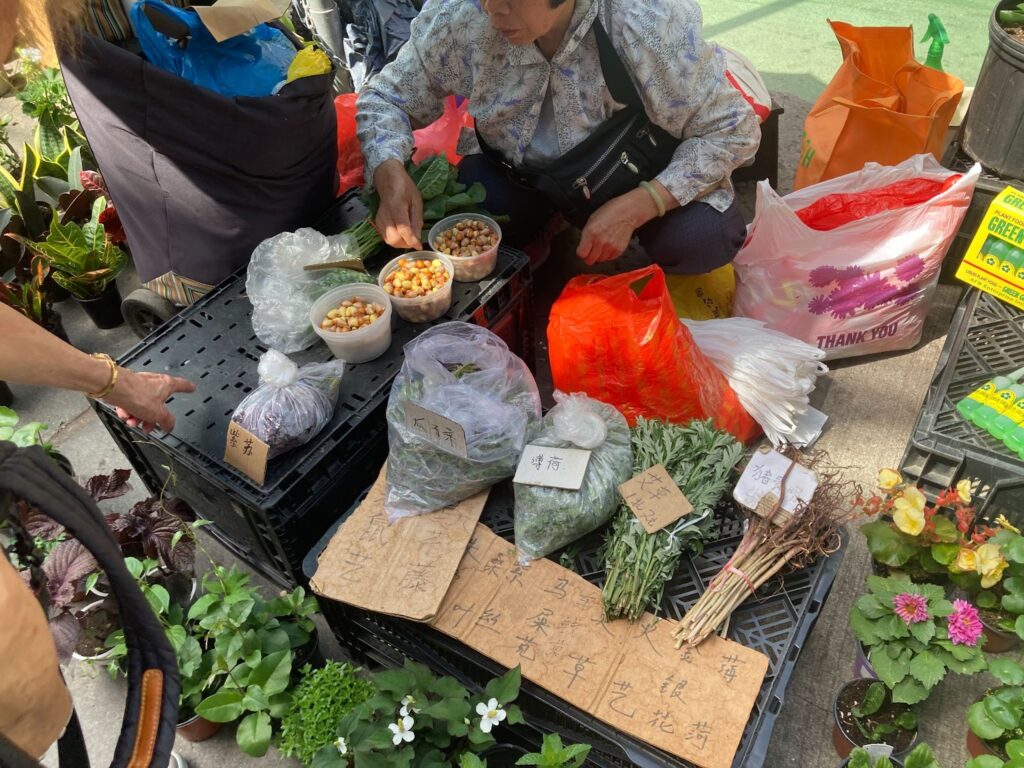
When we think of New York City, we think of Wall Street, the Statue of Liberty, the Broadway; we think of the story of Hamilton, Great Gatsby, the American Dream; we also think of stories of slavery, industrialization, displacement…Those are stories we are familiar with, stories about progress and conques at the expense of other human and non-human lives.
Mugworts do not fit into the story. The Chinese ladies who forage mugworts do not fit into the story. They are neither the hero who conquers, nor the victims who get killed. Their names do not even show up in the footnote of the story. They are just weeds that accidentally stick to the hero’s shoes, left out in the conquered land, and stay invisible in the margin between words. They are hard to notice – I have been living in the city for 7 years and only now I started to see them.
Yet in the margin they see each other; their life entangled for survival. On this land that buried violence, displacement, and trauma, the “unwanted” humans and the “unwanted” plants, both adapting to the new world, forged an intricate relationship with each other, long way from home.
The entanglement of living between the feral plants and their foragers in New York City tells an unfamiliar story, one that is easy to overlook because it does not align with the promise of progress. It is a story not about saving or destroying the environment but coexisting with an already damaged one; it’s not about extracting new resources but collaborating with other species for collective survival. Their story offers a way of imaging our world beyond capitalistic extraction and the modern conceit of progress.
6.
When I returned to Fort Tilden a month later, the baby mugworts that I had to crouch down to touch had grown to my shoulder-height. It was a sunny day with a cool spring breeze. I was there with Zoe again, shooting a documentary about her and her foraging practice.
As we walked down the sandy trail, the familiar aroma of mugworts rushed towards me. I can see them clearly now – how their silver and green leaves are shimmering in the sun. Alternating with the mugworts are seas of reeds, another invasive plant from Asia. At the borders of their colonies, there is a silent territory war going on—sometimes, the mugworts push forward, overwhelming the reeds; other times, the reeds reclaim their ground, smothering the mugworts. Oriental Bittersweet – you can probably have guessed at this point — another invasive plant from Asia – takes no sides in this battle. It climbs indiscriminately, twisting and coiling, thriving on them both.
This is a battle with no winner, no losers, no endings. It is an ongoing negotiation of resources. Without much human intervention, these plants simply exist, following their own seasonal rhythm of growing and expansion. And in each beat, they change each other’s life.
And there are the cherry trees in their full blossoms, standing among the feral thicket.
“These are Nanking cherries.” Zoe explained to us as she plucked a flower and nibbled it. “It is named after my hometown Nanjing and it probably got here during the military base era. I’m going to use it to make some salt-pickled cherry blossoms.”
Following Zoe, I plucked a flower from the branch—the petals were so thin and delicate. I placed one in my mouth and nibbled. An earthy and bitter flavor exploded on my tongue, with a pinch of sweetness. It tasted surprisingly good.
“Not bad, right?” Zoe said, as she took out a paper bag and started to collect the flowers. On each tree, she would only pick a few and then move on to the next tree. “I try not to take too many flowers on one tree.” She explained, “I also don’t take the prime flower on the tree … I don’t want to disturb their beauty. Look at them, they are so beautiful.”
They were beautiful. The pale pink and pure white whispered in the wind, casting a gentle glow over the mugworts below. Even though we were the only people here to appreciate their beauty – this patch of land mostly forgotten and unmanaged—she wanted to leave the beauty undisturbed.

Foraging is an act of taking, yet one that could – as in Zoe’s gesture of restraint – exist in harmony with the act of care.
When I asked Zoe if it is her intention to forage mostly the invasive plants to restore balance in the damaged environment, she gave a wry smile, “I don’t think we would ever be able to restore an ecosystem. No matter if we want it or not, these plants are already here and there is no turning back the clock.” She paused. “I just think the plants operate on a different timescale. On their own timescale they will figure out how to adapt and live together in ways we don’t know. I am just here to observe.”
7.
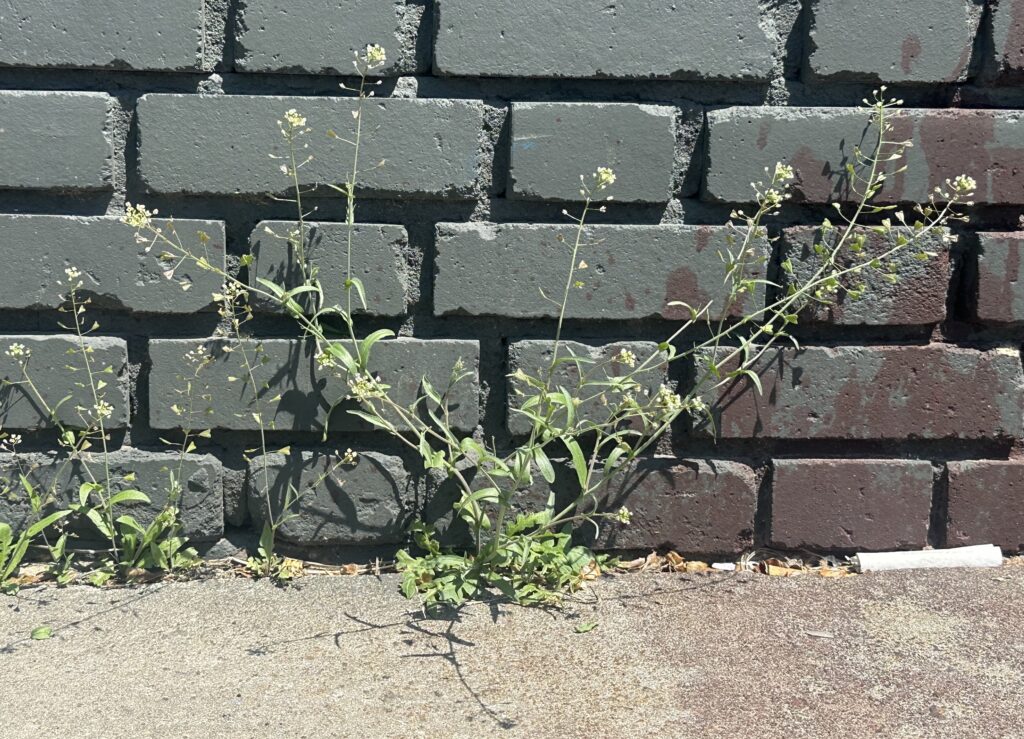
We are just here to observe. Zoe’s words lingered in my mind as I crouched down one morning to examine a newly sprouted plant with little heart-shaped leaves on my way to work. I later identified it as 荠菜 (jì cài, shepherd’s purse) through a plant-identifying app — a wild green often used in wonton fillings back in Shanghai, usually mixed with minced pork, sesame oil, and a pinch of salt.
The city now unfurls in a flux of new color, shape, smell, texture, and flavor that demands my attention, followed by questions: Who are you? How did you make it here? What are you growing into?
Foraging, at its core, is an art of noticing. It’s a practice of knowing through embodied sensory experience. To know where a mugwort colony would pop up and when a cherry flower peaks in its sweetness, one must learn through direct, sensory intimacy of touch, smell and taste and attune to subtle seasonal changes. Abstract, derivative knowledge does not hold here because the landscape is shaped by uncertainty. Mugwort colonies shift, reed beds expand, cherry trees that fruited last year may not fruit this year.
Recognizing change humbles me, reminding me that the illusion of control – or even just the well-minded intention to “design” a “sustainable” future only echoes our ignorance.
How do we unlearn the mindset of techno-fixes or techno-apocalypses that is embedded in our progress-driven capitalist narratives? How do we create projects and speculate a future that is grounded in care, cooperating, and co-becoming with other lives?
I was hoping to find inspiration for these questions from the urban foragers’ baskets, yet the journey of searching, trespassing and picking wild herbs only led me to question the question itself. By asking “how do we speculate a future”, we already center ourselves – humans – as the architect of all world-building projects. The feral plants growing on the post-industrial urban lands reminded me that with or without humans, critters and organisms are always making a living and adapting to damage we made; Life persists, not in grand utopias or apocalypses, but in the mess of adaptation, entanglement, and survival.
Donna Haraway proposed the term Chthulucene as a conceptual framework to think of the world that is actually being lived. Rejecting both Anthropocene and Capitalocene, it describes a world not dominated by human mastery, but composed of tentacular, multispecies interdependence. In her word, Chthulucene, is made up of “ongoing multispecies stories and practices of becoming-with in times that remain at stake.” (Haraway, 2016).
The stories of the urban foragers reveal the world of Chthulucene to me not as theory, but as lived, daily practice. The Chinatown ladies forage invasive plants for survival. Zoe forages the same plants to reconnect with lost flavors from home. Different yet intertwined migration histories and cultural knowledge guide them to patches of mugwort, but they are both here now—knowing they did not come to this land alone, and they do not move through the world alone.
They move through disturbed and transitional landscapes, not to restore a lost past or settle a troubled water, but to observe, adapt, and make-do with what emerges from a troubled present. In doing so, they open themselves up for unexpected collaborations and combinations, finding abundance in the “waste”. The practice also echoes what Haraway called staying with trouble, that is, “to dwell in the thick present”—or as Zoe said “There is no turning back the clock”. The plants are already here, and we are already here. In hot compost piles we become – with each other or not at all.
To take with care and to collaborate with other non-human lives is not a new idea. It predates the laws that now forbid it and the histories that named the plants “invasive.” But in the tale of progress and modernization dreams, we forgot. The logic of capitalism not only conditions us to see land as a single exploitable asset, but determines who and what is worthy of our care on a land. These diaspora urban foragers, adapting old skills in a “new land”, show us the possibilities of personal, grassroots acts of resistance to such extractive logic. Touching, tasting, picking, trespassing, they form relationships with a land that is composed of a living web of entangled, earthly beings rather than a single resource. They develop care for what power has deemed unworthy of care, cultivate kinship with what was deemed as waste. This is not heroic action, but slow, relational composition—multispecies worlding emerges from everyday acts of preparing a meal.
Still, I want to be careful here not to romanticize foraging—as Zoe warns, it can easily become a “liberal affection,” a performance of eco-consciousness. Foraging should not be seen simply as a “sustainable” practice or a solution to our current ecological dilemma – a mindset that will lead us back to the fallacy of “progress”. What foraging has offered me is a space to practice the art of noticing and to cultivate care—care as a matter of response-ability—not control, but the capacity and willingness to respond (The Matter of Care, Maria Puig de la Bellacasa, 2017). It prompts us to ask better questions, not one big speculative question—How do we build a better future?—but many small ones:
*What lives here? What returns each spring? What disappears? What plants grow together, and which push one another out? How do mugwort, reeds, and oriental bittersweet negotiate the land? And how do I, as a human, take part in these negotiations?
To ask such questions is where the work of care begins.
8.
Another spring is just making its way to New York. And this year, spring occurs to me differently. It’s not just the “Spring equation” mark in my Google Calendar or rearranging my clothes in the closet. It is seeing the field garlic and plantains first sprouting out from winter-barren ground in Sunset Park, followed by fresh mugwort leaves growing at the feet of last year’s dried mother plants. Cherry flowers are the first to bloom following a couple days of light rain, and when I see the pale pink flowers, I know it won’t be long before I can smell the flora of crabapple and magnolia.
The temporal rhythm of all those lives playing together, creating moments of harmony or dissonance, that is spring.
So for now, I invite you
to smell,
to touch,
to eat,
spring.
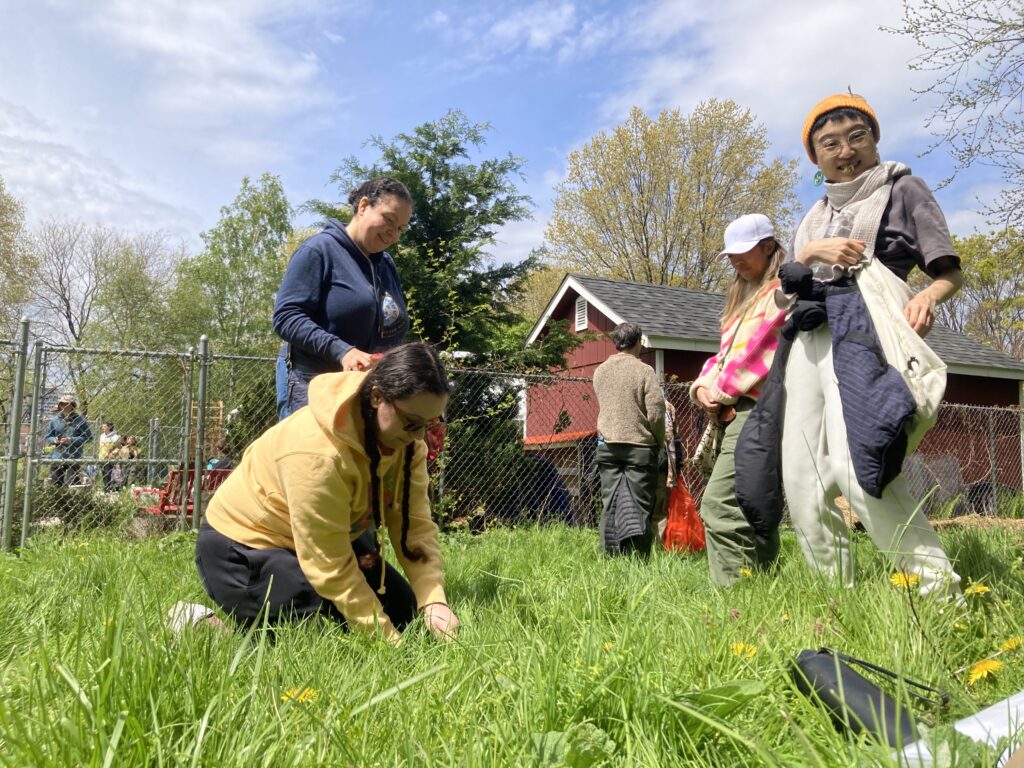
You can watch our documentary Eating Spring here.
